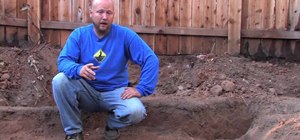Bamboo is easy to grow, but there are a few things you should know before starting. There are hundreds of species of bamboo and they can be roughly divided into either running or clumping bamboos. Almost all cold hardy bamboos are runners and almost all tropical bamboos are clumpers. Running bamboos send out root like rhizomes underground and can spread many feet each year. Clumping bamboos slowly expand and stay in a tight clump with canes close together. We grow dozens of cold hardy bamboo species, some will stay green down to -15 F.

I only grow running bamboos as it gets below freezing where I live, and they are capable of withstanding cold weather conditions. This article concerns growing running bamboos only. You can find lots of detailed information about bamboo by visiting the American Bamboo Society's website.
Step 1 Find your bamboo
To grow running bamboos, you should start with a small division of bamboo from an established grove of bamboo. The division must have a piece of the underground rhizome, otherwise it may live, but will not grow and spread. You can also use just a piece of rhizome, but this is slower and usually not as successful.
Step 2 Cut the rhizomes
When you find a grove of bamboo, look around the outside for a small, individual cane. You will need a shovel and something to cut the rhizome with. These are very tough and I usually use a small keyhole saw. As you dig around the plant, you will feel the rhizome once the shovel hits it. Take the saw or pruning shears and cut the rhizome below ground. You will usually find the rhizome in more than one place. Just cut anywhere the shovel hits.
Step 3 Pry the rootball out
When the rhizomes are cut and you have circled the plant with a shovel, about 6 to 8 inches deep, just pry the rootball out of the ground. If you have missed a rhizome, you can usually tell where it is as you pry. In most cases, the rootball and plant will pop right out as bamboo is very shallow rooted.
Step 4 Prune and water
Once you have the plant out of the ground, prune about 1/4 off the top. Because the plant has less roots, this will help keep it from wilting. Water the rootball and try to plant as soon as possible.
Step 5 Plant the bamboo
To plant, just dig a shallow hole slightly larger than the rootball. Place the plant in the hole and backfill with some good topsoil or compost. Mulch heavily with leaves or straw and water thoroughly. That's all there is to it!
Tips
There are a few things you need to know about bamboo, as it is different from most other plants.
- Bamboo likes water, but will not survive if the roots stay wet. This means you can also damage or kill the plant by overwatering. Just water enough to keep the roots from drying out, especially during dry spells. Once the bamboo is established, watering isn't usually necessary, but can help it grow faster.
- Bamboo responds well to fertilizer and will grow much faster if you feed it regularly with compost or fertilizer such as 8-8-8.
- The best time to transplant is in the fall. The only time you should avoid transplanting is in the spring when new shoots are emerging.

- A bamboo grove is actually one (or a few) plants. As the grove expands each year, it will put up more and larger canes each season. Each cane will get full size in a couple of months time and will never grow larger, even though it may live ten years. This means that a grove of "giant" bamboo can send up canes that are 6 inches in diameter and 70 feet tall each spring. Pictured above is a new Moso cane emerging in the spring. They usually grow about a foot a day.
Just updated your iPhone? You'll find new emoji, enhanced security, podcast transcripts, Apple Cash virtual numbers, and other useful features. There are even new additions hidden within Safari. Find out what's new and changed on your iPhone with the iOS 17.4 update.
























6 Comments
Did you take that last photo?
Yes, that is "Moso" bamboo, the largest cold hardy species. This is the bamboo used to make flooring and is the most popular for eating, mostly because the shoots are so large.
beautiful.
Could bamboo become an invasive species if transplanted in the wild in the US? If not, why? I would be very interested in growing some if it can survive Michigan's climate. If I were to purchase it online, do you have any suggestions for what I should look for?
There are a few species that are exceptionally cold hardy. Two of the most popular are Yellow Groove (P. aureosulcata) and Red Margin (P. rubromarginata). Both should stay green and leafy down to -10 to -15 F. Once they are well established they can likely survive even colder temperatures. Even thought they may suffer some top kill the roots should survive to send up new shoots. And yes, they can be very invasive. Even though most are not native to the U.S. (only two species are) bamboo can be found growing wild in many parts of the country. They do especially well in the southeast. There are dozens of groves of different species within a few mile of my nursery.
I planted the yellow running bamboo bamboo 12 years ago, it did not spread until I cleared my oak trees and let in the sun in, then in one year it spread from about 25 x 25 feet to 250 x 250 feet its caused a lot of damage here, had it all ripped out I deeply regret ever planting it, it gets down to zero here in my state of CT. It can climb over rocks, under rocks, nothing stops it, it will dig into stone walls go down 4 feet looking for a way under, or climb 6 feet over rocks and back down, it takes on any shape needed to live. I'm hoping the millions of tiny roots don't regrow the plant from hell. When dried it out as hard as bone, great for building material, but not in your back yard. Our state just passed a law making planting it illegal, if it grows out of your property.
Share Your Thoughts